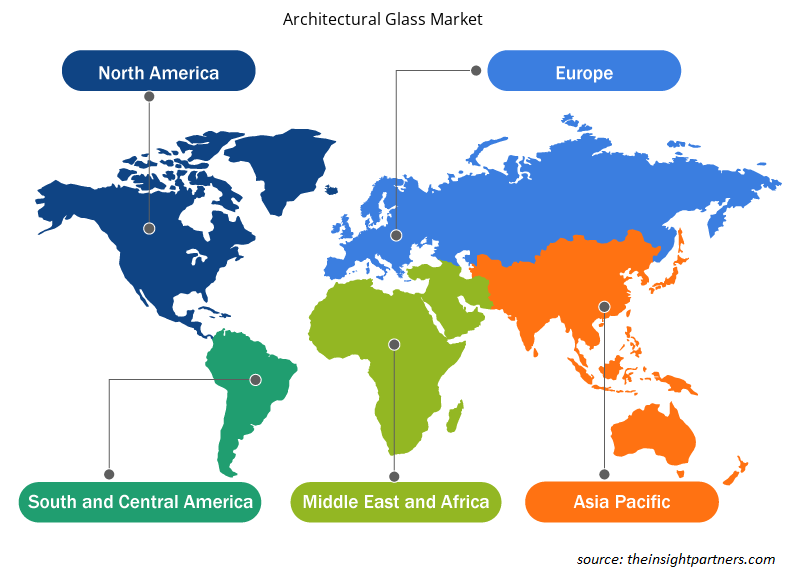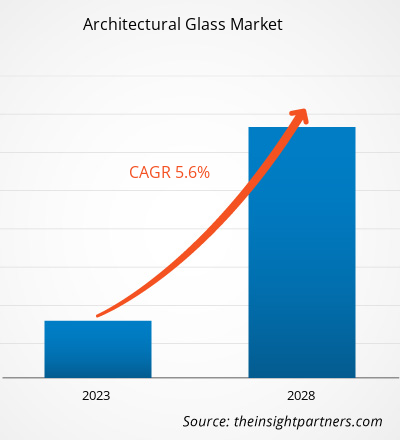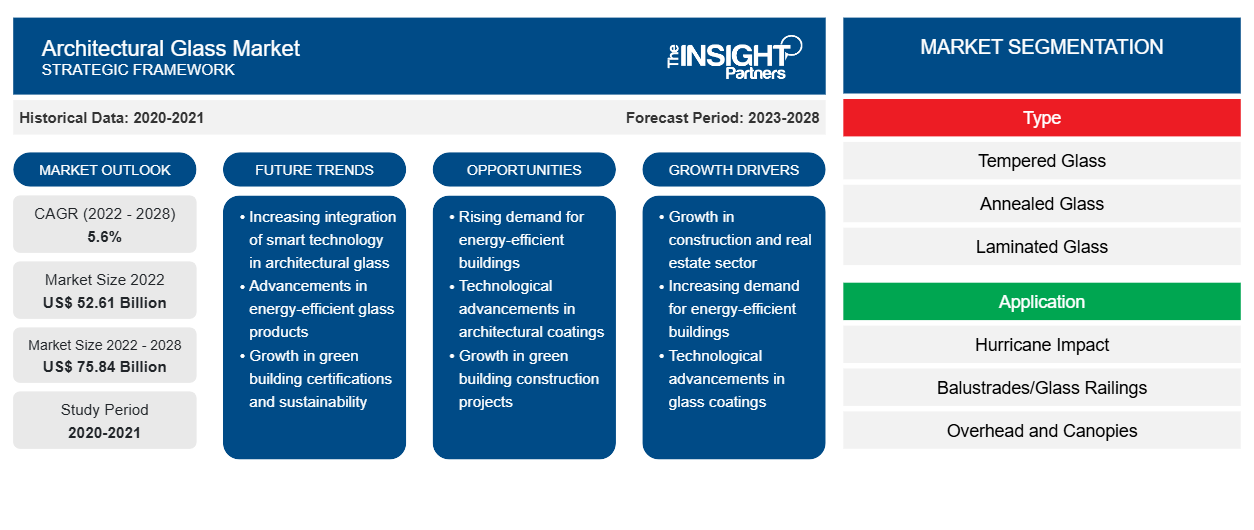건축용 유리 시장 규모는 2022년 52,608.27백만 달러에서 2028년 75,837.41백만 달러로 성장할 것으로 예상되며, 2022년에서 2028년까지 연평균 성장률 5.6%로 성장할 것으로 예상됩니다.
건축용 유리는 창문, 가정 및 사무실 문, 외벽 등의 투명한 유리 재료로 사용되는 건축 자재입니다. 증가하는 도시화는 전 세계적으로 증가하는 건설 활동에 기여하고 있습니다. 증가하는 인구 증가, 직업 기회를 위해 농촌에서 도시로 이주하는 사람들, 그리고 전략적 사업 투자는 건설 부문을 활성화하여 건축용 유리 시장 성장을 촉진하고 있습니다.
COVID-19 팬데믹이 건축용 유리 시장에 미치는 영향
2020년에는 국가 및 국제 경계가 폐쇄되어 가치 및 공급망이 중단되어 다양한 산업이 운영 속도를 늦춰야 했습니다. COVID-19 팬데믹은 봉쇄, 여행 금지 및 사업 중단으로 인해 경제와 산업에 부정적인 영향을 미쳤습니다. 정부 당국의 제한으로 인해 주요 원자재 공급망이 중단되고 제조 공정이 불규칙해지면서 화학 및 재료 산업에 직접적인 영향을 미쳐 건축 자재 생산과 수요가 방해를 받았습니다. 이러한 요인은 COVID-19 팬데믹 동안 건축용 유리 시장에 부정적인 영향을 미쳤습니다. 그러나 2021년에는 정부가 이전에 부과한 제한을 완화한다고 발표하면서 시장이 긍정적인 회복을 보였습니다. 제조업체는 수익성을 활용하여 최대 용량으로 작업할 수 있었습니다. 이 요인은 앞으로 몇 년 동안 시장을 주도할 것으로 예상됩니다. 예를 들어 Eurostat에 따르면 3월과 4월에 전례 없는 감소(-25.9%)를 보인 후 2020년 5월 유럽 연합의 건설 활동이 20.4% 증가했습니다. 이는 위기로 인한 손실 중 일부를 회복했습니다. 그 이후로 건설 활동은 대부분의 달에 증가했지만 그다지 역동적이지는 않았습니다. 2022년 1월 생산 수준은 2020년 2월보다 1.9%만 높았습니다.
귀하의 요구 사항에 맞게 이 보고서를 사용자 정의하세요
이 보고서의 일부 또는 국가 수준 분석, Excel 데이터 팩을 포함하여 모든 보고서에 대한 사용자 정의를 무료로 받을 수 있으며 신생 기업 및 대학을 위한 훌륭한 혜택과 할인 혜택을 이용할 수 있습니다.
- 이 보고서의 주요 시장 동향을 알아보세요.이 무료 샘플에는 시장 동향부터 추정 및 예측까지 다양한 데이터 분석이 포함됩니다.
시장 통찰력
컬러 및 인쇄 유리에 대한 수요 증가
경제 성장, 생활 수준 향상, 전 세계 인구의 현대화로 인해 인쇄 및 컬러 유리와 같은 장식용 유리를 주거 및 상업용 건물의 인테리어 디자인에 사용하는 것이 증가하고 있습니다. 건설 산업에서 스크린 인쇄 유리에 대한 수요는 전통적인 건축 자재에 비해 다양한 미적 이점을 제공하므로 증가하고 있습니다. 스크린 인쇄 유리는 디스플레이 창, 건물 외부 조경, 건축 공간 칸막이, 모자이크 유리, 가구 장식 및 기타 3D 객체와 같은 산업, 상업 및 건축 응용 분야에서 사용이 확대되고 있습니다. 이러한 유리 제조 품종의 발전은 건축용 유리에 대한 수요를 더욱 높일 것으로 예상됩니다.
유형 통찰력
건축용 유리 시장은 유형에 따라 강화 유리 , 열처리 유리, 적층 유리 등으로 구분됩니다. 적층 세그먼트는 예측 기간 동안 가장 높은 CAGR을 기록할 것으로 예상됩니다. 적층 유리는 견고하고 튼튼하며 내구성 있는 구조를 제공하고 견고하고 투명한 층을 제공하므로 기존 유리에 대한 좋은 대안입니다. 허리케인이나 기타 자연 재해의 위험이 높은 건물, 침입 위험이 높은 주거 및 상업용 건물의 창문, 보석, 수족관 또는 동물 사육장과 같은 귀중품의 진열장, 유리 바닥, 유리 계단, 채광창 및 유리 지붕에 사용됩니다. 또한 보안, 소음 감소, 깨짐 방지 및 악천후로부터의 보호에 대한 수요가 증가함에 따라 예측 기간 동안 시장이 꾸준한 성장을 보일 것으로 예상됩니다.
애플리케이션 인사이트
건축용 유리 시장은 적용 분야에 따라 허리케인 충격, 난간/유리 난간, 오버헤드 및 캐노피, 보안/방탄 유리, 음향, 장식/색유리, 구조용 파사드 등으로 세분화됩니다. 구조용 파사드 부문은 2021년 시장에서 가장 큰 점유율을 차지했습니다. 구조용 파사드 에서 건축용 유리는 유리 벽 클래딩 및 유리 벽 파티션에 널리 사용됩니다. 벽 클래딩은 일정 수준의 단열 및 내후성을 제공하고 건물의 외관을 개선하는 데 사용됩니다. 유리 클래딩은 건물의 외부 표면에 유리창을 사용하는 건축에서 널리 사용되는 기술입니다. 강화 유리는 벽 파티션에 사용되는 가장 일반적인 유리 유형입니다. 이 유리는 가열하여 강화하여 유리를 어닐링 유리보다 4~5배 더 강하고 내구성이 뛰어납니다. 이러한 요소가 세그먼트를 주도할 것으로 예상됩니다.
건축용 유리 시장에서 활동하는 주요 기업으로는 AGC Inc, Compagnie de Saint-Gobain SA, Guardian Industries Holdings LLC, Nippon Sheet Glass Co Ltd, Qingdao Morn Building Materials Co Ltd, Asahi India Glass Ltd, Turkiye Sise ve Cam Fabrikalari AS, Schott AG, Jinjing (Group) Co Ltd, Vitro SAB de CV가 있습니다. 이러한 기업은 고객 요구를 충족시키기 위해 고품질 제품을 제공하는 데 중점을 둡니다. 또한 연구 개발 활동에 대한 투자, 신제품 출시와 같은 전략에도 중점을 둡니다.
건축용 유리 시장 지역 통찰력
Insight Partners의 분석가들은 예측 기간 동안 건축용 유리 시장에 영향을 미치는 지역적 추세와 요인을 철저히 설명했습니다. 이 섹션에서는 북미, 유럽, 아시아 태평양, 중동 및 아프리카, 남미 및 중미의 건축용 유리 시장 세그먼트와 지리에 대해서도 설명합니다.

- 건축용 유리 시장에 대한 지역별 데이터 얻기
건축용 유리 시장 보고서 범위
| 보고서 속성 | 세부 |
|---|---|
| 2022년 시장 규모 | 526억 1천만 달러 |
| 2028년까지 시장 규모 | 758억 4천만 달러 |
| 글로벌 CAGR (2022-2028) | 5.6% |
| 역사적 데이터 | 2020-2021 |
| 예측 기간 | 2023-2028 |
| 다루는 세그먼트 | 유형별로
|
| 포함된 지역 및 국가 | 북아메리카
|
| 시장 선도 기업 및 주요 회사 프로필 |
|
건축용 유리 시장 참여자 밀도: 비즈니스 역학에 미치는 영향 이해
건축용 유리 시장 시장은 소비자 선호도의 변화, 기술 발전, 제품의 이점에 대한 인식 증가와 같은 요인으로 인해 최종 사용자 수요가 증가함에 따라 빠르게 성장하고 있습니다. 수요가 증가함에 따라 기업은 제품을 확장하고, 소비자의 요구를 충족하기 위해 혁신하고, 새로운 트렌드를 활용하여 시장 성장을 더욱 촉진하고 있습니다.
시장 참여자 밀도는 특정 시장이나 산업 내에서 운영되는 회사나 기업의 분포를 말합니다. 주어진 시장 공간에 얼마나 많은 경쟁자(시장 참여자)가 존재하는지 그 규모나 전체 시장 가치에 비해 나타냅니다.
건축용 유리 시장에서 운영되는 주요 회사는 다음과 같습니다.
- 주식회사 AGC
- 컴파니 드 생고뱅 SA
- 가디언 인더스트리 홀딩스 LLC
- 닛폰 시트 글라스 주식회사
- 칭다오 모른 건축자재 유한회사
면책 조항 : 위에 나열된 회사는 어떤 특별한 순서에 따라 순위가 매겨지지 않았습니다.

- 건축용 유리 시장 주요 업체 개요 알아보기
스포트라이트 보고서
- 건축용 유리 시장의 진보적인 산업 동향은 플레이어가 효과적인 장기 전략을 개발하는 데 도움이 됩니다.
- 선진국과 개발도상국 시장에서 성장을 확보하기 위해 기업이 채택한 사업 성장 전략
- 2020년부터 2028년까지 건축용 유리 시장의 정량적 분석
- 건축용 유리에 대한 세계 수요 추산
- 건축용 유리 구매자와 공급자의 효능을 설명하기 위한 포터의 5가지 힘 분석
- 경쟁 시장 시나리오를 이해하기 위한 최근 개발
- 건축용 유리 시장 성장을 주도하고 제한하는 요인과 함께 시장 동향 및 전망
- 상업적 이익을 뒷받침하는 시장 전략을 강조하여 의사 결정 프로세스 지원
- 다양한 노드에서의 건축용 유리 시장 규모
- 시장의 세부적인 개요 및 세분화, 건설 산업 역학
- 성장 가능성이 유망한 다양한 지역의 건축용 유리 시장 규모
회사 프로필
- 주식회사 AGC
- 컴파니 드 생고뱅 SA
- 가디언 인더스트리 홀딩스 LLC
- 닛폰 시트 글라스 주식회사
- 칭다오 모른 건축자재 유한회사
- 아사히 인디아 글라스 유한회사
- 투르키예 시세와 캠 파브리칼라리 AS
- 쇼트 AG
- 진징(그룹) 유한회사
- Vitro SAB de CV
- 과거 분석(2년), 기준 연도, CAGR을 포함한 예측(7년)
- PEST 및 SWOT 분석
- 시장 규모 가치/거래량 - 글로벌, 지역, 국가
- 산업 및 경쟁 환경
- Excel 데이터세트
최근 보고서
관련 보고서
사용 후기
구매 이유
- 정보에 기반한 의사 결정
- 시장 역학 이해
- 경쟁 분석
- 고객 인사이트
- 시장 예측
- 위험 완화
- 전략 기획
- 투자 타당성 분석
- 신흥 시장 파악
- 마케팅 전략 강화
- 운영 효율성 향상
- 규제 동향에 발맞춰 대응























 무료 샘플 받기 - 건축용 유리 시장
무료 샘플 받기 - 건축용 유리 시장